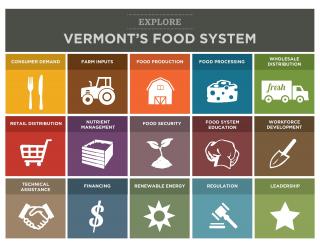Vermont’s Food System: Relocalize it!
February 17, 2015

The local food movement has been capturing media attention all across the country. Vermont, in many ways, is serving as the pace setter for focused, coordinated activity that is driving job and food business creation, economic output, and finding creative ways for all Vermonters to participate in this renaissance of ‘relocalized’ food.
“In 2009, when the Vermont Legislature set the Farm to Plate Initiative in motion, no one really knew what might come of it. As the Chair of the House Agriculture and Forestry Committee, I could not be more pleased,” said Carolyn Partridge, a state representative from Windham County. “We’ve seen incredible jobs creation, we’ve seen young people starting new farms, and we’re finding all sorts of creative ways to get fresh, local food onto the dinner table of Vermonters.”
Released last month, the 2014 Farm to Plate Annual Report reveals how Vermont’s farmers and food enterprises are increasing food production and how programs such as farm to school, farm to college and farm to hospital as well as the charitable food system are all working to increase the amount of fresh, local food that is available to Vermonters at all income levels.
Vermont’s farm and food economy is growing.
- From 2007 to 2012 food system economic output expanded 24%, from $6.9 billion to $8.6 billion.
Food manufacturing is growing at a faster rate than overall manufacturing in Vermont as well as food manufacturing in the other New England states.
- There are 748 food manufacturing firms in the state, a 37% increase over 2009 (539 firms).
- The number of food manufacturing jobs increased by 1,596 between 2009-2013. Vermont’s 34.5% increase grew at a faster rate than other New England states (MA=21%, NH=4.2%, CT=3.6%, RI=-1.5%, ME=-8.5%).
Crop and livestock sales are on the rise.
- The value of agricultural sales increased to $776 million in 2012, up from $746 million in 2007, a 4% increase. The number of farms with $10,000 or more in sales in 2012 was 3,018, a 5% increase from 2007 (2,883).
Job creation is strong.
- 4,189 new jobs (7.2% increase) were created in the food system from 2009 to 2013.
- For every 1 food system job created there are 1.28 additional jobs created in Vermont.
Vermont’s entrepreneurs are creating new businesses and thus, employment.
- 665 new farms and food businesses (5.9% increase) were launched in the food system from 2009 to 2013.
- Over 60,000 Vermonters are employed as farmers, waiters, cheese makers, brewers, bakers, butchers, grocery stockers, restaurateurs, manufacturers, marketers, distributors, and many other food related jobs. About 12,000 businesses are part of Vermont’s food system.
More businesses are sourcing local food.
- Sodexo spent $3.2 million on local food in 2014 served to Vermont college and university students at 16 campuses as well as at 4 addition locations.
- UVM Medical Center purchased $1.6 million in local food in 2014, including $343,000 directly from farmers (up 35% over 2013). They also purchased an additional $260,000 worth of food from regional food purveyors (up 18% over 2013).
- City Market, one of Vermont’s 17 consumer food cooperatives, reported $11 million in locally sourced food sales, or 31% of their total gross sales in 2014.
- The Vermont Food Venture Center in Hardwick processed 40,000 lbs. of locally grown produce for schools, colleges and hospitals in Vermont.
Innovation and collaboration across Vermont’s food access community is helping food insecure Vermonters.
- The Vermont Foodbank, state agencies, and many community food security organizations are bringing fresh local food to food insecure Vermonters and providing job training to underemployed and unemployed people.
- In 2014, the Vermont Foodbank distributed nearly 9 million pounds of food – over 1.3 million of those pounds were produce. This is the first time the Foodbank has distributed more than 1 million pounds of produce and is a 45% increase over the previous year. Of that, nearly 320,000 pounds were donated or gleaned from Vermont farms (a 9% increase over the previous year).
The Vermont Sustainable Jobs Fund, the non-profit coordinator of Vermont’s Farm to Plate Network, is responsible for reporting Farm to Plate Strategic Plan progress annually to the Vermont Legislature. Data is collected from a variety of sources including the USDA Census of Agriculture and Farm to School Census, and the U.S. Census Bureau’s Annual Survey of Manufacturers and Economic Census. Data sources and analysis relevant to each of the 25 goals of the Farm to Plate Strategic Plan can be accessed directly at the Farm to Plate website.
“Because of our small size, when we work together towards a shared goal, such as strengthening our local food economy, we can really make things happen. We see the fruit of our hard work, and so do others around the country — Wisconsin, New Mexico, Washington, Florida, Maryland, as well as the other New England states – who all inquire about the ‘secret sauce’ here in Vermont and look to Farm to Plate as a model for statewide food system development,” says Ellen Kahler, executive director of the Vermont Sustainable Jobs Fund which administers Farm to Plate.
Kahler also serves on the coordinating body of Food Solutions New England, which released A New England Food Vision in June 2014—a six state initiative to produce 50 percent of the food purchased by New Englanders by 2060. “Vermont can’t be an island. We’re never going to be able to provide all the food we need by ourselves. Even within New England, this 50% goal is going to be hard to achieve. But it serves to inspire us, to envision a different kind of food system, one that is more ecologically and health aligned with our values as Vermonters,” says Kahler. “The value of ‘local control’ is strong in Vermont. ‘Relocalizing’ where our food comes from, how it’s grown, raised or caught, and who benefits, matters. It’s about fairness and it’s something that Vermonters across our great state are making happen.”
Vermont’s Food System: Relocalize it!
Vermont Farm to Plate is the statewide initiative legislatively directed to increase economic development and jobs in Vermont’s farm and food sector and improve access to healthy local food for all Vermonters. The ten year Farm to Plate Strategic Plan to strengthen the working landscape, build the resilience of farms and food enterprises, improve environmental quality, and increase healthy, local food access for all Vermonters is being implemented by the Farm to Plate Network—over 350 farm and food sector organizations from across the state. Farm to Plate is coordinated by the Vermont Sustainable Jobs Fund, a non-profit organization based in Montpelier, Vermont. Learn more about the plan, network, and how progress is being tracked at www.VTFarmtoPlate.com.




